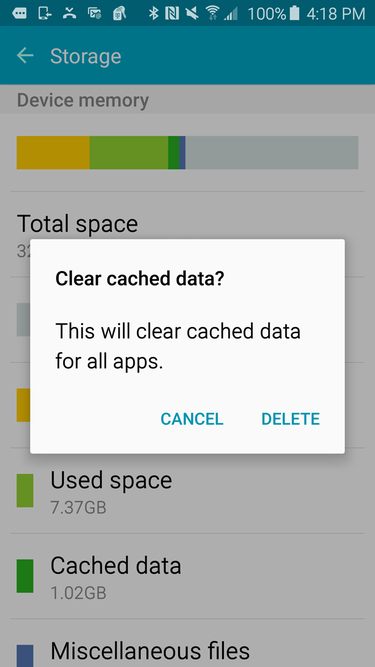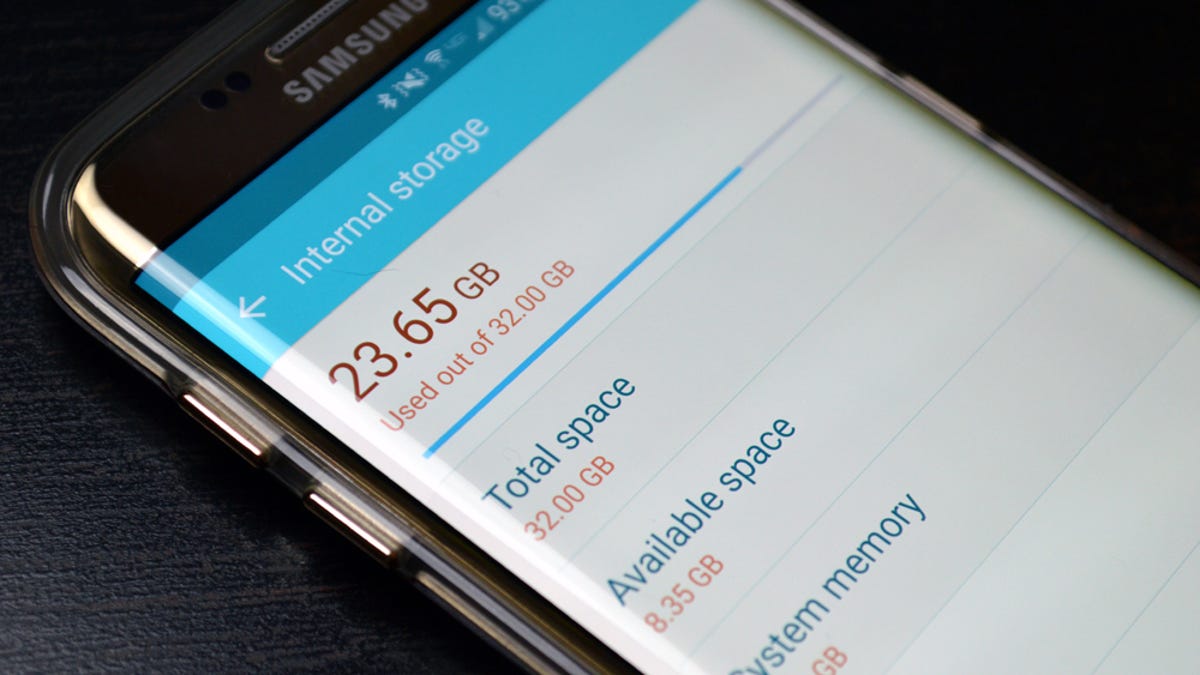Though 32GB, 64GB and 128GB of Android internal storage sounds large and adequate for daily use, it easily gets full in few years when you have lots of files piled up on your Android phone/tablet(especially apps and games, which might reach 100MB each). You know, we have dozens of apps installed on Android not to mention videos, music and photos. To avoid slow response, you need to get your Android phone a thorough cleanup. There are different methods provided for Android device users.
To clear cached data from all apps, go to Settings Storage and tap Cached data to clear the caches of all the apps on your phone. If you're running Android 6.0 Marshmallow on your device, like my Huawei Android 6.0, simply click on Files and then Clean up. This only can clear your app's cache, your app residual trash, unused app packages will also be detected and, on the advanced management of storage, you can check all your data usage exhaustively, and select certain contents to clean up. You can either tap and hold on the application and tap on the X button above the application icon to uninstall it; or tap on the menu button and choose to uninstall, select then the applications that you want to uninstall. Transfer applications to an external SD card Most Android devices have a slot for an external memory card. The 'system memory' Is where the Android OS is installed so there is no possibility to delete that. To clear the system memory, you would have to delete the app and then re-install it from the Google Play Store. Storage space and memory: mobile phone architecture versus PC architecture. With these simple tips and tricks, you can free up plenty of space on your Android device, and keep your phone's storage neat and tidy a bit longer. Step 1: Delete Unwanted Downloaded Files Android devices running 4.0 or higher come with a handy storage management interface.
Solution 1: Free Up Android Space without Losing Anything
1. Compress photos. The first thing we can do to free up our Android space is to compress Android photos without sacrificing photo quality. There are many photo compressing apps offering for help. You just need to download one on your computer and have photos and videos on your Android device scanned. After that, the app will show you the original size of your photo album and the compressed size.
2. Move apps to SD card. Apps will be installed on your phone by default if you didn't choose to install apps on SD card. To move apps to SD card, you just need to go to 'Settings' > 'Storage' > 'Internal storage' > 'Apps' > find the app > hit on 'CHANGE' > 'SD card' > 'MOVE'.

Solution 2: Copy Files to PC or Cloud

1. Upload Photos to Google Photos. Google Photos allows you to upload photos onto cloud with either high quality or original one. You can also upload other files and documents to Google Drive and other cloud storage service.

2. Copy Files from Android to Computer. Make sure that the important files you want are included and back up your Android phone. Just simply back them up to your computer with Android data manager. After making sure that your Android phone data is copied, you can delete the photos, videos or music that is not frequently used from your Android. The deleted files are not gone forever, you can recover them back with FonePaw Android Data Recovery anytime you like.
Solution 3: Delete Useless Files or Uninstall Bloatware
1. Clear App Cache. As we use our Android app, some cache files on your Android phone will be added up. To get more space, you have to clear app cache from time to time. Go to 'Settings' > 'Apps' > choose the apps > hit on 'Storage' > 'CLEAR CACHE'.
Increase Memory On Android Phone
2. Delete useless file folder. Another way to wipe Android files for more space will be deleting useless folders or files with Android file category direction.
3. Delete useless files with Root Explorer. Install Root Explorer and locate '/data/local' directory. Then, find the folder named 'rights' or 'tmp' and empty the folders. After that, the apps that failed to be installed will be erased.
4. Root Android and remove bloatware. There are many bloatware pre-installed on our Android phone, to get Android phone tidied up, we can root Android phone to get the superuser mode and you can now uninstall pre-install apps by going to 'Settings' > 'Apps' > choose the app > 'UNINSTALL'.
Solution 4: Factory Reset Android Phone
If the methods above don't work for you, you have to try to factory reset your Android phone: Go to 'Settings' > 'Backup & reset' > 'Factory data reset' or flash a new ROM for Android phone to get more Android phone.
As you can see, there are many useful way to free up Android space when the internal phone memory is full. Try them one by one to get more storage for your Samsung Galaxy S7/S6 Edge+/S6, HTC, Sony, Motorola and more Android phone and tablet.

Anyone with a smartphone will be veryfamiliar with seeing the dreaded “storage almost full” message flash up on the screen.For those who have ignored these warning signs long enough, it may even read“storage full”. Running out of memory can be quite annoying and disruptive,particularly if it happens just before you need to do something which requiresstorage space.
For most Apple or Android users, this message will first appear when you are very close to reaching your storage limit, usually about 500MB before. It often shows after you’ve tried to download a new app, that album you’ve been looking forward to or while shooting a video. If the file size is larger than what’s remaining, the prompt will appear and indicate that you need to make room.
The good news is that you don’t have to putup with it. There are simple steps you can take to help stretch your phone’sinternal memory and make use of every megabyte you have.
Transferphotos and videos out of internal storage
We’re all guilty of taking photosand recording videos, and then forgetting to delete them. Over time, thesefiles can accumulate and take up a lot of storage.
Android Storage System Memory
By offloading these files to a cloud-basedsystem, it can make a huge difference. If you’re using an iPhone, go toSettings > Apple ID > iCloud > Photos and tap the iCloud Photo Librarytoggle to turn the service on. Once you’ve enabled iCloud Photo Library, yourphotos and videos will automatically upload to iCloud so you’re free to deleteany locally stored files. Apple provides a certain amount of storage for free,with more available for a small fee.
Android users can set up Google Photos toautomatically back up files by launching the app and going to Settings >Back Up & Sync. Google lets you back up unlimited photos and videos forfree, up to 16MP and 1080p HD. You can then access them from any phone, tablet,or computer on photos.google.com.
Beyond iCloud and Google Photos, there arevarious apps you can use to upload your photos and videos to an online account,including Dropbox and Flickr.Alternatively, you could always go through your albums and delete what you donot need.
New user for mac. Getrid of those unwanted apps
Another habit that we all get into isdownloading apps for a specific purpose (or amid a gaming fad – who remembersFlappy Bird?) and then forgetting to delete them. These apps take up asurprisingly large amount of space and if left without updates, can cause yourphone to slow down.
To see how much space each app occupies,iOS users can go to Settings > General > iPhone Storage. On an Androidsmartphone, open Settings > Storage > Apps.
By deleting a handful of apps, you couldpotentially free up as much as 500MB with little or no effort.
Removeunnecessary downloads
Unlike a few years ago, our phones nowcontain lots of downloaded content. From podcasts to Netflixepisodes, to music, eBooks and documents. Much like unwanted apps, these areoften downloaded and forgotten about. If you no longer need or use them, deletethem and free up space for new content.
Deleteold text message threads
Is ccleaner for mac free. When you send and receive text messages,your phone automatically stores them for safe keeping. If these texts containimages or videos, they can take up a considerable amount of space.
Fortunately, you do not need to go back andmanually delete all your old text messages. Both Apple and Android phones allowyou to auto-delete old messages.
To enable this feature in iOS, go toSettings > Messages and scroll down until you see Message History. Then, tapKeep Messages and change Forever to 30 Days or 1 Year. Immediately after,you’ll be prompted to delete older messages.
For other devices – like Samsung phones– you simply need to head to Settings and make sure “delete old messages” is toggledon.
By following these tips, you will besurprised at how much storage you can save and in turn, how little you begin tosee those pop-ups again.
Next ArticleWhat technology is helping us go contactless during the pandemic?
